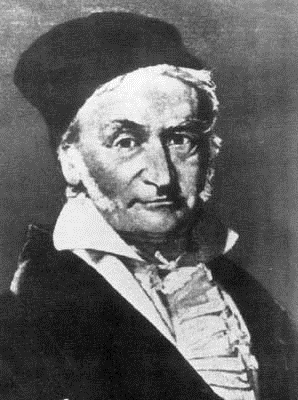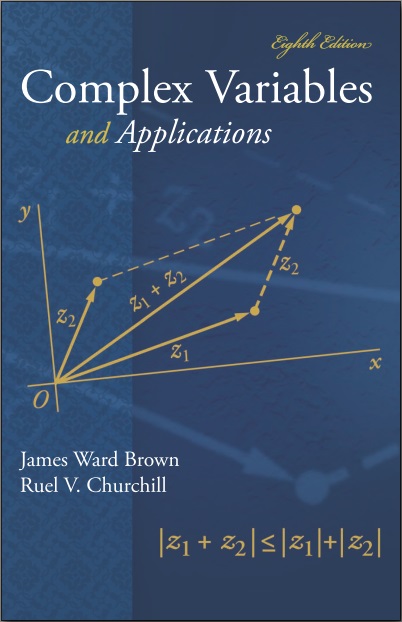 Carl F. Gauss, 1777-1855 |
 Augustin L. Cauchy, 1789-1857 |
 Georg F. B. Riemann, 1826-1866 |
 Carl F. Gauss, 1777-1855 |
 Augustin L. Cauchy, 1789-1857 |
 Georg F. B. Riemann, 1826-1866 |
COURSE NUMBER: MATH 4337 (MATH 5337 for graduate students)
TIME: 1:20-2:40 TR; PLACE: Gilbreath 104
INSTRUCTOR: Robert "Dr. Bob" Gardner; OFFICE: Room 308F of Gilbreath Hall
OFFICE HOURS: 4:15-4:45 TR and by appointment; PHONE: 439-6979 (Math Office 439-4349)
E-MAIL: gardnerr@etsu.edu
WEBPAGE: Dr. Bob's faculty webpage
(see my webpage for a copy of this course syllabus, copies of the classnotes in PDF, and updates for the course).
TEXT: Complex Variables and Applications, 8th Edition, by James Ward Brown and Ruel V. Churchill (McGraw-Hill, 2009). A 9th edition of the book is now in print and that is also an acceptable text (as are other editions of the book; the class notes are based on the 8th edition, though).


PREREQUISITE: The catalog states that Calculus 2 (MATH 1920) and Linear Algebra (MATH 2010) are the prerequisites, but some knowledge of Calculus 3 (MATH 2110) would be useful, in particular the ideas of a function of two variables and partial derivatives.
DESIRE2LEARN: I will not rely on the Desire2Learn ("D2L") website for the posting of notes and supplements; all of this material is freely available on my faculty webpage and does not require a login. I will use D2L to collect homework (in DropBox) and to post your grades, homework solutions, and recordings of class lectures.
CLASS NOTES: We will use projected digital notes for the presentation of definitions, examples, and proofs of some theorems. Copies of the notes are online. It is recommended that you get printed copies of the notes before the material is covered in class. This will save you from writing down most notes in class and you can concentrate on listening and supplementing the notes and examples with comments which you find relevant. You should read the online notes to be covered in class before each class (we will not have class time to cover everything in the notes; they are very thorough). Try to understand the examples and the meanings of the definitions. You should also read each relevant section of the book, paying particular attention to examples.
VIDEOS: Videos are available for many (but not all) of the sections which we will cover. Videos are accessible through my Online Complex Variables webpage, which includes links to videos on YouTube. No login is required to see the videos.
ABOUT THE COURSE: Complex analysis is basically the study of analytic functions. As we will see, a function of a complex variable is often much better behaved than a function of a real variable! We will introduce the complex numbers as an extension of the real numbers. We explore the complex plane and give a geometric interpretation of results whenever possible. Analytic functions are defined, differentiated, and integrated. We'll extend several familiar functions (such as logarithms, exponentials, and trig functions) from the real to the complex setting. We'll prove the Fundamental Theorem of Algebra and the Maximum Modulus Theorem. If time permits, I will discuss some of my research results which are related to topics in the class. We may have the opportunity to briefly explore applications.
OUTLINE:
Our tentative outline is:
Chapter 1. Complex Numbers: Algebra, modulus, conjugates, exponential form, argument, products and quotients, roots, topology of the complex plane.
Chapter 2. Analytic Functions: Functions, mappings, limits, limits involving infinity, continuity, derivatives, Cauchy-Riemann Equations, polar cordinates, analytic functions, harmonic functions, reflection principle.
Chapter 3. Elementary Functions. Exponential function, logarithm function, branches of the logarithm, complex exponents, trigonometric functions, hyperbolic functions, inverse trig functions.
Chapter 4. Integrals. Derivatives of functions w(t), definite integrals of w(t), contour integrals, branch cuts, moduli of integrals, antiderivatives, Cauchy-Goursat Theorem, simply/mulitply connected domains, the Cauchy Integral Formula, Liouville's Theorem and the Fundamental Theorem of Algebra, Maximum Modulus Theorem, Applications of the Maximum Modulus Theorem to polynomials.
Chapter 5. Series (Time Permitting). Convergence of sequences and series, Taylor series, Laurent series, absolute and uniform convergence, continuity/integration/differentiaion of power series.
GRADING: Your grade will be determined by the average on a midterm (M), a final (F), and homework (HW). Your average is determined by:
TESTS AND HOMEWORK: The final will not be comprehensive. Homework will be assigned and collected at roughly one week intervals. The homework problems will be almost exclusively from the text book. YOU MUST SHOW ALL DETAILS ON THE HOMEWORK PROBLEMS!!! Justify every step and claim you make - this is how you convince me that you know what you are doing. You may find some answers online, but these rarely sufficiently justify all steps and are unacceptable as homework solutions. In addition, you will be given hints as to how to work the homework problems and proofs; following these hints will be part of the instructions for the homework. Homework will usually be due on Saturdays through DropBox in D2L. You will need to create PDFs of your homework to electronically submit it.
ACADEMIC MISCONDUCT: Once you start a test, you must stay in the room until you complete it or until the class time is over. If you have a documented medical need to leave class during the test then this will, of course, be honored (provided you give me the documentation before hand). I will provide all paper for the tests. You will only need a pencil and eraser. You will put your backpack at the front of the classroom during the test and your phone will be placed on the table at the front of the room (so please make sure you have the phone silenced). Cheating on a test will result in a grade of 0 on that test. This is an example of academic misconduct and I will have to act on this as spelled out on ETSU's Academic Integrity @ ETSU webpage (last accessed 10/21/2025). When such a charge is lodged, the dean of the College of Arts and Sciences is contacted. Repeated or flagrant academic misconduct violations can lead to suspension and/or expulsion from the university.
SUPPLEMENTAL REFERENCES:
SYLLABUS ATTACHMENT: You can find an on-line version of the university's syllabus attachment (which contains general information concerning advisement, honor codes, dropping, etc.; accessed 10/21/2025).
ZOOM AND REMOTE ATTENDANCE: A ZOOM meeting is set up for each lecture through D2L. I encourage you to attend the in-person lectures if possible, but if you need to attend though ZOOM then that is fine. In particular, if you are not feeling well the please do not attend class in person. You can ask questions through D2L and I will respond, just like in class. These ZOOM meetings will be recorded and posted on D2L.
CAMPUS SAFETY: East Tennessee State University is dedicated to creating a safe and healthy environment for all students, faculty, staff, and visitors by fostering a strong culture of safety that extends beyond compliance with regulations. All members of the ETSU community play a crucial role in this shared responsibility. You are encouraged to report any issue without fear, ensuring a supportive environment. As Buccaneers, make safety a priority and contribute to a positive, productive campus community by:
IMPORTANT DATES: (see the official ETSU calendar for more details; accessed 10/21/2025):
| |
|||
1.3. Further Properties Graduate Problem(s) |
|||
Return to Dr. Bob's webpage
Last updated: October 21, 2025.